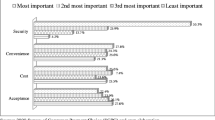Abstract
Payment modes (e.g., cash vs. credit card) vary in the transparency of the outflow of money. Smartcards (multifunctional cards), which bundle payment with non-payment functions (e.g., loyalty programs, identification, and other information functions), have become an increasingly popular payment mode. This shift toward multifunctionality in payment modes is assumed to reduce payment transparency and consequently to decrease consumers’ recall accuracy of past expenditures. We employ a field study to examine recall accuracy for recent purchases with cash, a single-function card, and a multifunctional card. We find that recall accuracy is lower when using a single- or a multifunction card than cash. We also find that it is not the multifunctionality of the card that results in a higher recall error but the individual usage patterns: A higher usage frequency of the non-payment functions results in a higher recall error.
Similar content being viewed by others
References
Bagchi, R., & Block, L. G. (2011). Chocolate cake please! Why do consumers indulge more when it feels more expensive? Journal of Public Policy & Marketing, 30(2), 294–306.
Brunel, L., Oker, A., Riou, B., & Versace, R. (2010). Memory and consciousness: trace distinctiveness in memory retrievals. Consciousness and Cognition, 19(4), 926–937.
Cohen, J., Cohen, P., West, S. G., & Aiken, L. (2003). Applied multiple regression / correlation analysis for the behavioral sciences (3rd ed.). Mahwah, NJ: Erlbaum.
Eurosmart. (2016). Facts & figures. http://www.eurosmart.com/facts-figures.html. Accessed 1 August 2017.
Geraci, L., & Rajaram, S. (2004). The distinctiveness effect in the absence of conscious recollection: evidence from conceptual priming. Journal of Memory and Language, 51(2), 217–230.
Geraci, L., & Rajaram, S. (2006). The distinctiveness effect in explicit and implicit memory. In R. R. Hunt & J. B. Worthen (Eds.), Distinctiveness and Memory (pp. 210–234). Oxford: Oxford University Press.
Heath, C., & Soll, J. B. (1996). Mental budgeting and consumer decisions. Journal of Consumer Research, 23(1), 40–52.
Hunt, R. R., & Elliot, J. M. (1980). The role of nonsemantic information in memory: orthographic distinctiveness effects on retention. Journal of Experimental Psychology: General, 109(1), 49–74.
Inman, J. J., Winer, R. S., & Ferraro, R. (2009). The interplay among category characteristics, customer characteristics, and customer activities on in-store decision making. Journal of Marketing, 73(5), 19–29.
Kamleitner, B., & Erki, B. (2012). Payment method and perceptions of ownership. Marketing Letters, 24(1), 57–69.
McDaniel, M. A., Dunay, P. K., Lyman, B. J., & Kerwin, M. L. E. (2013). Effects of elaboration and relational distinctiveness on sentence memory. The American Journal of Psychology, 101(3), 357–369.
Prelec, D., & Loewenstein, G. (1998). The red and the black: mental accounting of savings and debt. Marketing Science, 17(1), 4–28.
Prelec, D., & Simester, D. (2001). Always leave home without it: a further investigation of the credit-card effect on willingness to pay. Marketing Letters, 12(1), 5–12.
Raghubir, P., & Srivastava, J. (2008). Monopoly money: the effect of payment coupling and form on spending behavior. Journal of Experimental Psychology. Applied, 14(3), 213–225.
von Restorff, H. (1933). Über die Wirkung von Bereichsbildungen im Spurenfeld. Psychologische Forschung, 18(1), 299–342.
Rick, S. I., Cryder, C. E., & Loewenstein, G. (2008). Tightwads and spendthrifts. Journal of Consumer Research, 34(6), 767–782.
Runnemark, E., Hedman, J., & Xiao, X. (2015). Do consumers pay more using debit cards than cash? Electronic Commerce Research and Applications, 14(5), 285–291.
Shah, A. M., Eisenkraft, N., Bettman, J. R., & Chartrand, T. L. (2016). “Paper or plastic?”: how we pay influences post-transaction connection. Journal of Consumer Research, 42(5), 688–708.
Shelfer, K. M., & Procaccino, J. D. (2002). Smart card evolution. Communications of the ACM, 45(7), 83–88.
Soman, D. (2001). Effects of payment mechanism on spending behavior: the role of rehearsal and immediacy of payments. Journal of Consumer Research, 27(4), 460–474.
Soman, D. (2003). The effect of payment transparency on consumption: quasi-experiments from the field. Marketing Letters, 14(3), 173–183.
Sussman, A. B., & Alter, A. L. (2012). The exception is the rule: underestimating and overspending on exceptional expenses. Journal of Consumer Research, 39(4), 800–814.
Thomas, M., Desai, K. K., & Seenivasan, S. (2011). How credit card payments increase unhealthy food purchases: visceral regulation of vices. Journal of Consumer Research, 38(1), 126–139.
Voss, K. E., Spangenberg, E. R., & Grohmann, B. (2003). Measuring the hedonic and utilitarian dimensions of consumer attitude. Journal of Marketing Research, 40(3), 310–320.
Weber, A. (2007). The convergence of mobile data phones, consumer electronics, and wallets: lessons from Japan. Telematics and Informatics, 24(3), 180–191.
Zeithaml, V. A. (1982). Consumer response to in-store price information environments. Journal of Consumer Research, 8(4), 357–369.
Acknowledgments
We thank Michael Blens, Marc Heise, Paula Risius, Leonie Schiedek, and Oliver Zabel for their help with data collection. We also thank Katherine Burson, Scott Rick, and the members of the research seminar in economic and social psychology of the University of Cologne for comments on previous versions of this manuscript.
Author information
Authors and Affiliations
Corresponding author
Rights and permissions
About this article
Cite this article
Gafeeva, R., Hoelzl, E. & Roschk, H. What else can your payment card do? Multifunctionality of payment modes can reduce payment transparency. Mark Lett 29, 61–72 (2018). https://doi.org/10.1007/s11002-017-9445-2
Published:
Issue Date:
DOI: https://doi.org/10.1007/s11002-017-9445-2




